Written & illustrated by Melissa Sweet
$16.99, ages 4 and up, 40 pages.
A man with a knack for making things move turns the concept of marionettes upside down and creates one of the greatest parades on Earth.
In this marvelous tribute, Caldecott Honor winner Melissa Sweet uses a menagerie of objects and illustrations to tell the story of Anthony "Tony" Sarg, the artist behind Macy's parade balloons.
Sweet's telling is wondrous, as she echoes Tony's creative genius with her own playful use of wood, fabrics, color and sketches.
Whimsical collages delight the eye as Sweet mixes photographs of thread spool towers, a building block tiger on wheels and other objects with watercolor illustrations.
On the opening page, the book's title hangs on a cardboard sign from antique pulleys and wire. Later, a worn book is opened flat and filled with hand-sewn puppets, sketched diagrams, swatches of fabric and buttons.
The story itself moves along with a skip and bounce, and is sprinkled here and there with curious anecdotes to amuse readers.
Sweet writes that from boyhood on Tony tinkered with simple machines. He rigged pulleys and ropes to make dolls do jumping jacks and used those same mechanisms to let out the family's chickens from their coop while he was still in bed.
Tony ran rope from the door of the chicken coop through his bedroom window, then closed that door, sprinkled feed just outside of it and went off to bed. When his alarm rang in the morning, he pulled the rope, opening the door so the chickens could wander out and eat.
When Tony was full grown, he discovered the art of marionettes was a fading, so he revived the craft with his own style of wood and cloth puppets that moved like real actors. Eventually Tony was invited to perform with his puppets on Broadway.
0 Comments on Balloons Over Broadway as of 1/1/1900
When my daughter was growing up, we lived a hop, skip, and a jump from the Museum of Natural History. That was great just in itself, but it also meant that every Thanksgiving we were at the starting point for the Macy's parade. My daughter was less than a week old when I bundled her up and took her to the parade. She spent the entire time gazing at my face, but still I felt like a real parent for the first time. As she grew, we usually skipped the parade. It was soooo crowded that we watched it on TV. But we still had our traditions. On Wednesday night we'd go to the museum grounds, where workers would be blowing up the balloons for the big day. It was fun to wander up and down the streets and see our favorites as they filled with helium and magically came to life. Of course, eventually word got out and that too became soooo crowded.
Balloons Over Broadway takes me back to those days. This amazing picture book tells the story of how Tony Sarg, a puppeteer, came to invent the gigantic balloons that are the hallmark of the Macy's Thanksgiving Day parade. Like many icons, the balloons just always seemed to exist, so kudos to
Melissa Sweet for unearthing how they developed from blimp-like rubber balloons carried on wooden sticks to the soaring helium-filled wonders of today.
Melissa Sweet, a Caldecott Honor winner, obviously threw herself into this book. The artwork, a combination of watercolor illustrations and collages made from found objects, fabrics, and handmade puppets, exude the creativity and love of play that Sarg devoted his life to. In an authors note, Sweet tells us that she "played with all sorts of materials, not knowing exactly what the outcome would be." The end result shows that it was time well spent.
The book concludes with additional info about Tony Sarg, as well as a bibliography. The back end papers feature a 1933 advertisement from the New York Times, touting the upcoming parade. Among the "helium filled monsters" is one I would give anything to see: "The Colicky Kid: Listen to him squall!! He's mad. He's bad. He yowls bloody murder!"
And head on over to Sweet's website to view her
Balloons Over Broadway activity kit. It has fun templates of puppets for kids (or anybody) to make.
Balloons Over Broadway: The True Story of the Puppeteer of Macy's Parade
by Melissa Sweet
Houghton Mifflin, 40 pages
Published: November 2011
Fall is coming quick to Maine. It seems amazing that the summer has come and gone so quickly, but there it is. We've been stacking wood, fitting a new propane stove and insulating. The leaves are tinging red and yellow, birds are gathering, the garden is giving up it's last thrust of produce and it's time to think about submitting dummies. Well, it is in this house anyway!
Submitting is something I haven't been doing much of lately. The last two months I have been deep into finishing the final illustrations for the next two chapter books in the 'All Star Cheerleader' series for Kane and Miller by Anastasia Suen. Each book has 23 black and white illustrations and colour covers. You can buy the first one on line right now!
In fact I was so deep into them that I even forgot to blog! Wowser!
So, that is why I am thinking about submitting dummies ... I have several hanging around, and they are no good loafing around on my desk, it's out into the world they go. It's back to the CWIM to research likely publishers and fingers crossed on interest and not rejections. But, hey ho!
The hurricane passed us by uneventfully (Irene). Power off for a bit, but nothing horrible. Poor Vermont, they had a rough time, we were lucky. I will be glad when hurricane season is over, although all we get usually is humidity and a deal of rain. I don't mind rain, but if I wanted humidity I would have stayed in South Carolina.

I did make time to visit the Camden Book Fair and listen to some excellent authors and illustrators. It was nice to take a few hours out. Here's who attended ... I got some fabby signed copies!
How many do you know? Spot Toni Buzzeo, Jeannie Brett, Chris Van Dusen, Stephen Costanza, Cynthia Lord and Melissa Sweet amongst others.
The beautiful harbour and library in Camden, Maine.
All of which gave me some great inspiration for my own work. It occurs to me that this is the first time since October 2010 that I haven't been illustrating a book for someone else. It has been fantastic, and it has been a little frustrating ... working on my own projects has been limited. Hence no submissions. This week I have been reviewing and rethinking. There are new stories I would like to work on. Heck, I would love to get back to the MG I star

By:
Betsy Bird,
on 5/29/2011
Blog:
A Fuse #8 Production
(
Login to Add to MyJacketFlap)
JacketFlap tags:
Uncategorized,
Katherine Paterson,
Liz Burns,
Lemony Snicket,
Margaret Mahy,
Virginia Duncan,
Patrick McDonnell,
apps,
John Rocco,
Daniel Handler,
Melissa Sweet,
Rita Williams-Garcia,
Cindy Pon,
Day of Dialog,
Malinda Lo,
Matt de la Pena,
Paul Griffin,
Lisa Von Drasek,
Julie Kagawa,
Meghan McCarthy,
app trailers,
Dave Roman,
Adam Gidwitz,
Thanhha Lai,
Caroline Fraser,
Eden Phillpotts,
Linda Braun,
Martha Parravano,
Scott Gordon,
Add a tag
 So let’s get a grasp on what exactly it is I’m talking about here. Day of Dialog. A day when School Library Journal and roughly 1.5 billion children’s book publishers (read: 16, give or take) get together and attendees (who are mostly children’s librarians and children’s booksellers) get to witness a variety of interesting panels and previews of upcoming children’s books for the Fall season. It tends to be held on the Monday before BookExpo so that it doesn’t conflict with anything going on at that time. And since my library was closed that day for it’s big time Centennial celebration, I thought to myself, “Why not go? I could report on what went on and have some fun along the way.”
So let’s get a grasp on what exactly it is I’m talking about here. Day of Dialog. A day when School Library Journal and roughly 1.5 billion children’s book publishers (read: 16, give or take) get together and attendees (who are mostly children’s librarians and children’s booksellers) get to witness a variety of interesting panels and previews of upcoming children’s books for the Fall season. It tends to be held on the Monday before BookExpo so that it doesn’t conflict with anything going on at that time. And since my library was closed that day for it’s big time Centennial celebration, I thought to myself, “Why not go? I could report on what went on and have some fun along the way.”
Of course I had forgotten that I would be typing all that occurred on Dead-Eye the Wonder Laptop: Capable of carrying at least two hours of charge in its battery . . . and then dying altogether. So it was that I spent much of the day seeking out outlets and either parking myself next to them or watching my charging laptop warily across a crowded room. Hi-ho the glamorous life.
I was hardly the only person reporting on the day. Swift like the bunnies are the SLJ posts on the matter including the article BEA 2011: Paterson, Handler, Gidwitz a Huge Hit at SLJ’s Day of Dialog.
Day of Dialog is useful in other ways as well. It means getting galleys you might otherwise not have access to. It means sitting in a nice auditorium with a belly full of muffin. Interestingly the only problem with sitting in the audience when you are pretty much nine months pregnant (aside from the whole theoretical “lap” part of “laptop computer”) is that you start eyeing the panelists’ water bottles with great envy. I brought my own, quickly went through it, and then found myself wondering at strategic points of the day and with great seriousness “If I snuck onto the stage between speakers, do you think anyone would notice if I downed the remains of Meghan McCarthy’s bottled water?” I wish I could say I was joking about this.
 Brian Kenney, me boss o’ me blog and editor of SLJ, started us off with a greeting. He noted that he had placed himself in charge of keeping everything on track and on schedule. This seemed like a hazardous job because much of the day was dedicated to previews of upcoming books, and there is no good way to gently usher a sponsor off of a stage. Nonetheless, Brian came equipped with a small bell. Throughout the day that little bell managed to have a near Pavlovian influence on the panelists. Only, rather than make them drool, it caused them to get this look of abject fear that only comes when you face the terror of the unknown. For some of them, anyway. Others didn’t give a flying hoot.
Brian Kenney, me boss o’ me blog and editor of SLJ, started us off with a greeting. He noted that he had placed himself in charge of keeping everything on track and on schedule. This seemed like a hazardous job because much of the day was dedicated to previews of upcoming books, and there is no good way to gently usher a sponsor off of a stage. Nonetheless, Brian came equipped with a small bell. Throughout the day that little bell managed to have a near Pavlovian influence on the panelists. Only, rather than make them drool, it caused them to get this look of abject fear that only comes when you face the terror of the unknown. For some of them, anyway. Others didn’t give a flying hoot.
“It wasn’t wallpapering.”
Keynote Speaker Katherine Paterson
Luann Toth came after Brian to introduce our keynote speaker though, as she pointed out, “Does anyone really need to introduce Katherine Paterson?” Point taken. Now upon entering the auditorium this day, each attendee had been handed a signed copy of a new novel by Ms. Paterson and her h

outlier/flickr
Thought it might be nice to spread a little sunshine today. I know Spring has barely begun, but already I'm craving late summer peaches. There's nothing like a just ripe peach -- blushing and golden, sweet and juicy, a perfect orb bursting with the sunny goodness of lazy summer days.

keanalee*/flickr
Now, I truly love peach pie. I'd walk a mile for a piece of warm peach pie, double or lattice crust, flaky and buttery, all melty and velvety in my mouth. And, as some of you may know, I love Melissa Sweet's art. She's one of my top ten favorite children's book illustrators of all time. What happens when you combine two things you love so much? Well, I can barely stand it -- the joy, the swooning, the admiration, the dreamy reverie of it all, the sweet resonance of my senses fully sated.

kthread/flickr
In three words: EASY AS PIE, a.k.a., a picture book written by Cari Best and illustrated by Melissa Sweet, all about baking a peach pie.
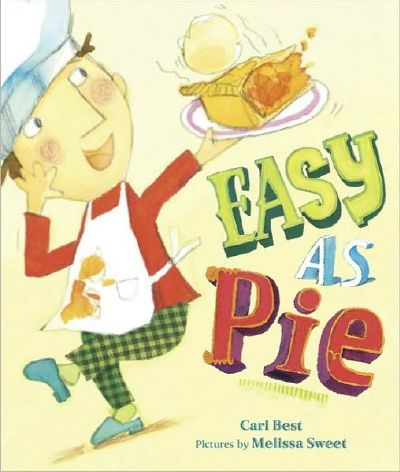
I will try to contain my gushing long enough to tell you a little about it, but no guarantees. Like the profoundly perceptive, self-proclaimed picture book nerd Julie Danielson of 7-Imp, I am fond of utilizing superlatives when it comes to good stuff. There's no sense in trying to be restrained or even reasonable when it comes to picture book love, because it's a genre that by its very definition (if there ever was one) emotes emotes emotes all the wonder, fun, beauty, joy, surprise, fears, disappointments, curiosity, and all-knowingness of childhood.
So, budding chef Jacob is making his very first pie after watching Chef Monty on his favorite TV show. Throughout the process, he's mindful of Chef Monty's Baking Rules, which include things like, "A happy baker bakes a happy pie," and "If something unexpected happens, fix it as best as you can." What I love is how palpable Jacob's love of cooking is, and how single mindedly he presses on despite his sister distracting him and the family trying to rush him so they can go out to dinner.
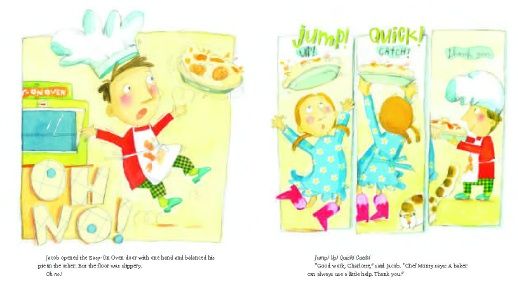
(click to enlarge)
He makes a few mistakes along the way, as is expected, but manages to surprise his family with a totally delicious end product. Lots of verve in the language, I like that. Great story about problem solving with lessons applicable to everyday life, and Jacob's own baking rules may be the best ones of all: "It's no fun eating a fresh pie all by yourself," and "A happy pie eater makes a baker happy!"
Jacob, with his ro
By:
Phoebe,
on 11/4/2010
Blog:
The Children's Book Review
(
Login to Add to MyJacketFlap)
JacketFlap tags:
Food and Drink,
Gennady Spirin,
Thanksgiving,
Lauren Thompson,
Jonathan Bean,
Valeri Gorbachev,
Melissa Sweet,
Amelia Bedelia,
Jennifer Donnelly,
Charlotte Riley-Webb,
Ages Four to Eight: Books for pre-school to second grade,
Book Lists: Specialty picks,
Seasonal: Holiday Events,
Marjorie Priceman,
Lynne Avril,
Kathleen D. Lindsey,
Picture Book - Wordless,
Stephen Gammell,
David Martin,
Herman Parish,
Cari Best,
Shari Halpern,
Zoe Hall,
Add a tag
By Phoebe Vreeland, The Children’s Book Review
Published: November 4, 2010
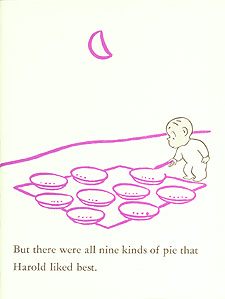 Thanksgiving is a time for pie. Pie makes me think of Harold and his purple crayon. Remember that picnic on the sandy beach? “There was nothing but pie. But there were all nine kinds of pie that Harold liked best.” My daughter and I love to imagine what all the different fillings could be. Who doesn’t love freshly baked pie, the most amazingly delectable dessert that fills the home with its tantalizing aroma? It’s such a perfect vehicle for a scoop or dollop of some cool creamy topping. Kids love to help bake, especially mixing, licking their sweet, sticky fingers and rolling out pie dough.
Thanksgiving is a time for pie. Pie makes me think of Harold and his purple crayon. Remember that picnic on the sandy beach? “There was nothing but pie. But there were all nine kinds of pie that Harold liked best.” My daughter and I love to imagine what all the different fillings could be. Who doesn’t love freshly baked pie, the most amazingly delectable dessert that fills the home with its tantalizing aroma? It’s such a perfect vehicle for a scoop or dollop of some cool creamy topping. Kids love to help bake, especially mixing, licking their sweet, sticky fingers and rolling out pie dough.
Here follows a list of picture books—all about pie—to share with your little ones. Some simply get your mouth watering, but most are laced with a secret ingredient. There is a reminder about abundance, a lesson on humility, and a tale of perseverance. You will also find a trip around the world, a juicy alphabet primer and a cautionary tale for the literal-minded—from Amelia Bedelia, of course. A few even include a recipe so good that you won’t need to invite a very hungry moose and deserving porcupine to help you finish.
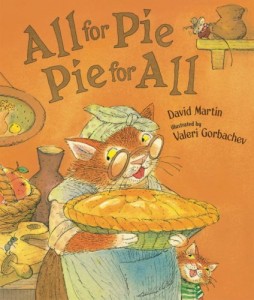 All for Pie, Pie for All
All for Pie, Pie for All
by David Martin (Author), Valeri Gorbachev (Illustrator)
Reading level: Ages 0-5
Paperback: 32 pages
Publisher: Candlewick; Reprint edition (August 12, 2008)
Source: Library
Publisher’s synopsis: In this merry, multi-species story cooked up with folksy warmth and humor, everybody gets a piece of the pie — and then some.
Grandma Cat makes a delicious apple pie, and there’s plenty for everyone — and even a piece left over. Grandma Mouse finds a piece of apple pie, and there’s plenty for everyone — and even crumbs left over. Grandma Ant spies some crumbs of apple pie, and there’s plenty for everyone. But what’s left over after cats, mice, and ants have had their fill? Little readers will eat up this scrumptious, gently math-related story that’s as sweet and satisfying as a fresh-baked dessert.
Add this book to your collection: All for Pie, Pie for All
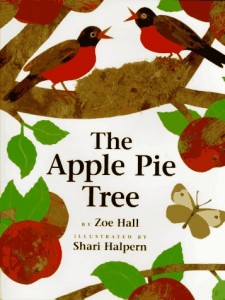 The Apple Pie Tree
The Apple Pie Tree
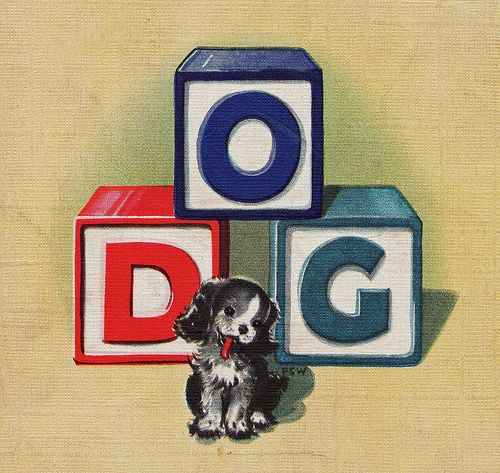
from The ABC Book by Florence Sarah Winship (Whitman Publishing, 1940).
calsidyrose/flickr
Holy Dog Breath!
The alphabet soup kitchen has been hijacked by dogs!
They're everywhere, everywhere! Lapping up tequila and expensive mineral water, leaping through hoops, barking, whimpering, panting, jumping on the furniture, and licking all my stamps! Some want me to read Shiloh to them over and over again, while others are demanding doggie massages. And I'm running out of biscuits and chew bones!
All because Thursday is National Dog Day, and some of these clever critters got whiff of my plan to post pics of them with their children's author companions. Ever since I put out the call, there's been a steady stream of these tail wagging, tale telling, marvelous mutts ringing my doorbell.
Look who dropped by today:

Melissa Sweet with Rufus and Nellie! You may remember from my interview with Melissa that she's a huge dog lover and animal shelter advocate. She wrote and illustrated this doggie book:
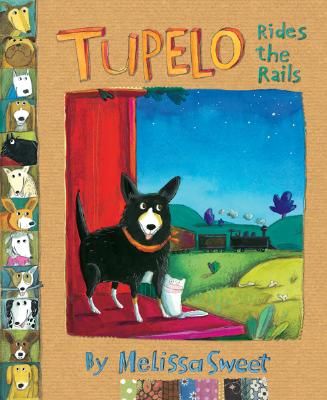
By the by, Melissa tells me that Rufus is a 10-year-old Australian Shepherd mix, the sweetest dog on the planet. Nellie is a 4-year-old Sheltie, who lives to herd anything that moves, even semi trucks. Her eyes dart back and forth at the sound of jake brakes.
When told about National Dog Day, Rufus said, "I thought every day was dog day . . . does this mean special treats?"
Nellie's only response was:
treattreathurryhurryc'monletsgoletsgorrararararasquirrelRRrrrooof!
Guess who else padded their way into the kitchen?
Jackie Urbanovic with her dogs Max and Cuba!


Max and Cuba.
Max the dog is not to be confused with Max the Duck, star of her wildly popular picture book series, which in addition to Max, features Brody the dog and lots of other cool animals.
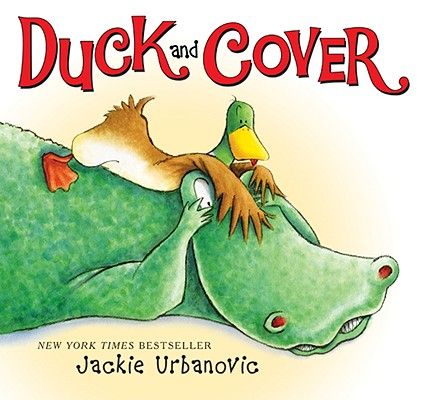
Jackie also shared this adorable picture of her with her childhood dog, Dodo,
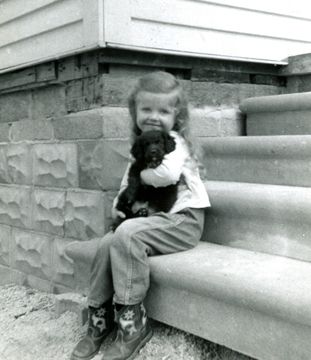
Absolutely adorable (love those boots)!
this one of Irene, who's the character in the Max series with a house full of animals,
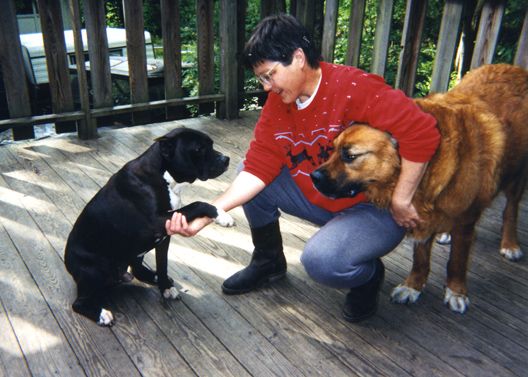
Scrappy and the real Irene and Brody.
and

This beautiful book is illustrated by one of my favorite children's book artists, Melissa Sweet.
The book is based on a timeless song, written by Peter Yarrow, of the legend folk singing group Peter, Paul & Mary. It is a meditation on the earth, the environment, and the kinship of all living creatures. Melissa's tender animal characters and rich watercolors bring the song to life. The book also comes with an audio CD which will download right into your itunes library. For those of you who love to sing to your kids, this book will bring calm and peace to their bedtime....and yours!
 I may not be putting pencil to paper for my own book these days, but I'm thinking about the final size of it as a much bigger component than I had before. How much do you consider size when working on a dummy? How often do you think about the size of books?
I may not be putting pencil to paper for my own book these days, but I'm thinking about the final size of it as a much bigger component than I had before. How much do you consider size when working on a dummy? How often do you think about the size of books?
Last year I noticed a few oversize board books at our Barnes & Noble. A gigantic version of Freight Train had me tweeting 'Why?' My son has the 'normal' size book and it seemed just right. Since then, we've acquired a few books bigger and smaller than what I assumed was the average sized board book.
Now that my son is mobile, the giant Moo Baa La La La seem to stop him from a distance, just catching his attention as he toddles along. He'll play while standing at the couch, but so far he doesn't seem interested in flipping the pages in these behemoths. It's just too heavy. So I'm starting to see the value a bit, but I still find myself asking, Why? Is this size appealing for daycare centers, so workers can read to a group of toddlers without worrying about tearing of delicate pages? Will it be interesting to him when he's actually big enough to carry it, or will he prefer picture books? Is this targeted at reluctant readers, who want to feel BIG but can't sit for a more complex story? Or is it just another way to try and make money for the publishers? Not that I'm against it, but I feel like books should be the right size, for the right age and child.
The average sized board book has been our mainstay. Whether square or horizontal, it serves us well for laptime, wandering, stacking, flipping, grabbing, and loving. We prefer the native board books, not those picture books that have been shrunk down, although a few of those seem to work just as well (I Kissed the Baby comes to mind). Hanukkah Lights is no longer seasonal, but that hasn't stopped us from reading it often. It's a perfect first Melissa Sweet book, don't you think?
And last, but not least... the tiny book. Oh, how we loved this little apple-shaped book when we checked it out of the library! That's why its my pick for this month (see sidebar). I'm still thinking about tracking it down to buy, that's how much we miss it. It just fits in his little hands. It's light enough to carry everywhere - and really it got carried everywhere. And the illustrations inside charmed us over and over. Richard Scarry is timeless, even if some of the vehicles are a bit dated (a metal toothpaste car, and actual jar of yogurt as the yogurt car, etc.). I definitely understand the value in such a dear little object, especially with the scale and detail in the illustrations on white. I checked out a big picture book of Richard Scarry's and it just didn't have the same appeal - for either of us actually.
So what do you think, dear readers? Big, Little, Teeny - or all of the above?
#19 in an ongoing series of posts celebrating the alphabet.
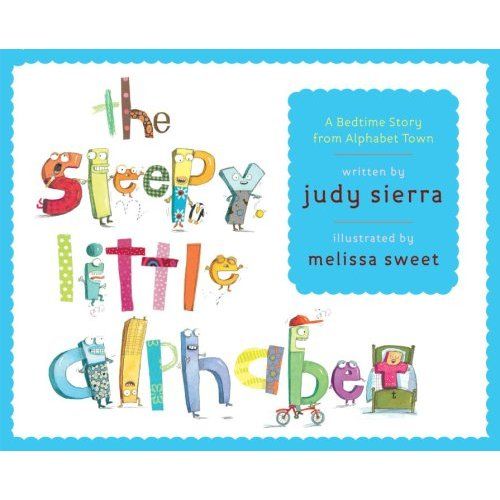
Sshhhhhh!
I hope you don't mind my whispering, but I finally got all the lower case letters to go to sleep. As soon as I opened this doozy (or should I say dozy) of a picture book, those little rascals skitter-scattered every which way and their UPPER CASE parents kind of looked at me like this -- :o(.
But I know it's not my fault. Every time anyone tries to read this funny bedtime story the same thing happens. Even though they should be settling down and going to sleep, all the little letters find something they'd much rather do -- jump on the bed, play the accordian, read funny stories, take a bath, giggle and fidget. Typical, I say. Alphabet midgets run amok!
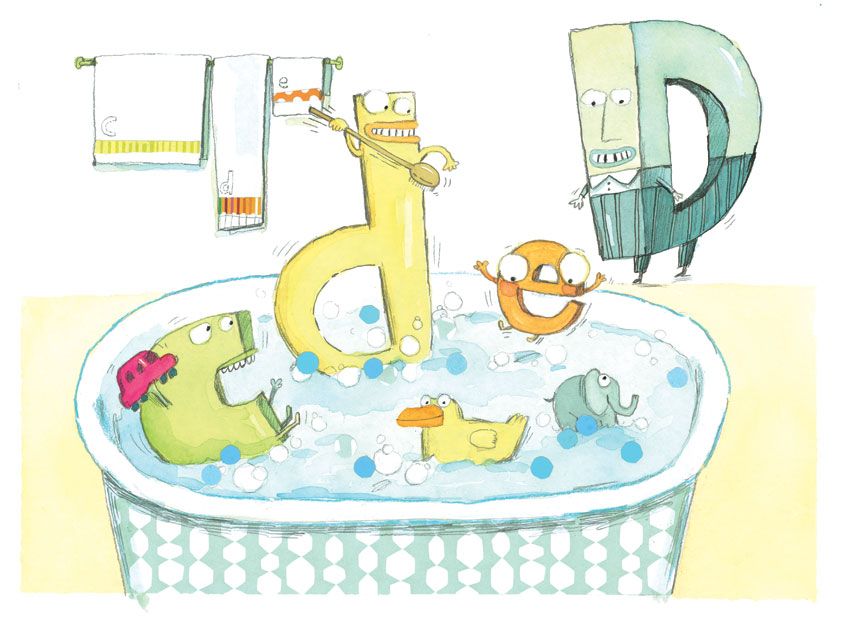
Just between you and me, I like them that way. Judy Sierra's done a brilliant job of capturing all their naughty and nice antics in rollicking rhyming couplets -- the lower case letters have a ball flexing their poetic muscle while they oh-so-cleverly elude bedtime (at least for most of the book). Some of these imps even alliterate: "f is full of fidgety wiggles./g has got the googly giggles."
And the illos? You know how I feel about Melissa Sweet. It wasn't enough she had to nail the impish personalities of letters big and small in all their goggly-googly-eyed glory. No! In addition to a jumble of shapes, textures, patterns and hilarious expressions rendered in pencil, watercolor, and collage, she just had to add a plethora of polka dots! *swoons* I. am. mad. for. dots!
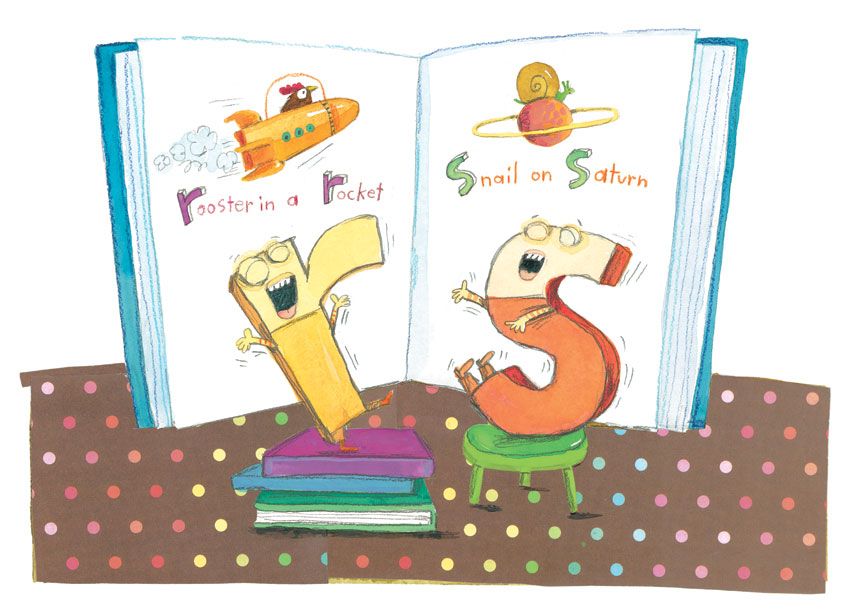
Pint-sized alphabet learners will love all the giggle-worthy detail. Clothed letters with teeny tiny hands and feet. And those toothy grins would make any dentist proud! Each spread includes objects beginning with the featured letter (for "T" there's a telephone, turtle, t-shirt, teddy bear and tea set!). Melissa is famous for all those charming little touches that go straight to the heart of what kids love and look for in a book.
Did I mention the polka dots?
There are a ton of alphabet books out there, but Judy and Melissa have managed to create one that's fresh (slap me!), zany, and vvvvvibrating with energy. Just wait till you see all the little letters going through their bedtime paces, and then finally dozing in their cozy beds. The Sleepy Little Alphabet earned a *starred review* from Horn Book and was awarded a 2009 Oppenheimer Toy Portfolio Award. A great read aloud and fun primer. Go out and grab it!
Oops. I shouldn't have yelled. They're up again.
The Sleepy Little Alphabet by Judy Sierra,
illustrated by Melissa Sweet
Knopf (2009), Ages 3-6, 40 pp.
Review copy provided by publisher.
(Finally, somebody besides me who truly believes the alphabet is alive . . .)

Jen Bryant's biography of poet William Carlos Williams for the grade-school reader is just the type of biography any poet would want. In A River of Words: The Story of William Carlos Williams, the poetry and its writing remain more important to the tale than the events of the poet's life.
So, while we learn William Carlos Williams loved to spend time outdoors, wandering, as a child, we also discover what was most important about these childish excursions: "...as he walked through the high grasses and along the soft dirt paths, Willie watched everything" and "the river's music both excited and soothed Willie. Sometimes, as he listened to its perfect tune, he fell asleep."
Bryant tells us of William Carlos Williams as a student, but most importantly about his study of poetry:
Poetry suited Willie. Every night,
he looked forward to sitting at his desk
and writing a few lines.
But after a while, he grew frustrated.
He had pictures in his mind that didn't fit exactly
into steady rhythms or rhymes.
'I have never seen a swan or an archer,' Willie thought.
'I want to write about ordinary things--
A River of Words is a biography of a poet--of how a young person becomes, lives, and works as a poet. Indeed, William Carlos William's career as a doctor plays second fiddle to practical, yet lyrical, descriptions of how he managed to write poetry in the evenings after work.
Melissa Sweet's illustrations are warm and make much use of Williams's poems and other textual elements (notepads, drafts, textbooks). A River of Words: The Story of William Carlos Williams is a first-class biography, and one to use in the classroom to learn not only about Williams, or more about poetry, but also to learn more about biography and how different biographical approaches can approach a life in radically different ways.
-----------------------
A River of Words: The Story of William Carlos Williams
by Jen Bryant, illustrated by Melissa Sweet
Eerdmans Books for Young Readers, 2008
ISBN: 0-8028-5302-8
-----------------------
Other Blog Reviews:
One Minute Book Reviews
Fairrosa's Reading Journal
A Fuse #8
Achuka
Bookends
Don't miss Jama Rattigan's interview will illustrator Melissa Sweet at Alphabet Soup.
----------------------
Susan Taylor Brown has the roundup at Susan Writes.
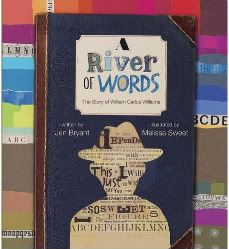
This is just to say we have selected the winners in our Melissa Sweet Book Giveaway!
After riding around in a red wheelbarrow and consuming an inordinate number of juicy plums, Cornelius got right down to work.
First, he wrote all the entrants' names on colorful pieces of paper. He was very pleased with himself.

But who would have the high honor of actually picking the winners?
The ever clever Cornelius then had a flash of genius (this happens on a regular basis). "Melissa is from Rockport, Maine," he mused. "Isn't that a quaint, seaside fishing village?"
"Why yes," I said, biting into a plum.
"Well, instead of tossing these names into a hat, why not toss them all into a giant teacup? Melissa apparently drinks a lot of tea. Then we can fish for the winners!"
So, Cornelius folded all the papers into the shape of fishes.

A brilliant idea, I had to admit. But I also knew this idea could turn into another fiasco, where certain parties would be fighting over the fishing pole. Well, I underestimated Cornelius' foresight, because he raced to the Paddington closet and recruited the only bears fully qualified for the job.
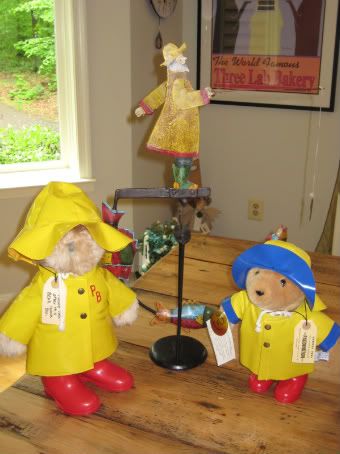
Both wore yellow slickers and answered to the name of "Gorton."
Cornelius carefully baited the pole,

then Big G snagged the first winner (for the Cheese book),

and Little G snagged the second winner (for A River of Words).

And they are: *drum roll please*

Jen W. of Eclectic Reader and LJ's Susan Taylor Brown!
*cue in thunderous applause and marching band music*

CONGRATULATIONS, JEN, ON WINNING THE CHEESE BOOK, AND SUSAN FOR WINNING A RIVER OF WORDS!!
And thanks to all of you who entered. Please stay tuned for more interviews and giveaways right here at alphabet soup!
Oh, before you go, why not have a plum?

photo by Morgan Rowe
THIS IS JUST TO SAY
I have eaten
the plums
that were in
the icebox
and which
you were probably
saving
for breakfast.
Forgive me
they were delicious
so sweet
and so cold.
~William Carlos Williams

Melissa with Rufus and Nellie.
Friends, I’m tickled pink and over the moon, because our very special guest at alphabet soup today is 2009 Caldecott Honor Medal winner, Melissa Sweet!
I can’t think of a better way to top off National Poetry Month, than with the illustrator who so brilliantly rendered the story of how Willie Williams, a doctor from Rutherford, New Jersey, became one of America’s most influential twentieth century poets.

If you’ve seen Melissa’s masterful work in A River of Words: The Story of William Carlos Williams (beautifully written by Jen Bryant), then you know the award was supremely well deserved. Her mixed media collages embody the very soul and spirit of the poet, who “walked through the high grasses and along the soft dirt paths . . . stretched out beside the Passaic River . . . watched everything,” took notes “about things he’d heard, seen, or done . . . looked at the words . . . and shaped them into poems.”
I learned from Melissa's website bio that these words by poet Mary Oliver are posted above her drafting table: “To pay attention, this is our endless and proper work.” Melissa says, “That’s good, because I often find myself taking walks, gardening, biking, but I’m taking it all in and it somehow shows up in my books.” Like Williams, Melissa is a keen observer, chronicler, and collector. She is constantly on the lookout for all manner of found objects and ephemera to use in creating her exuberant, charming collages. Quite amazing is the childlike spirit that always shines through in very sophisticated works of art. Her illos are endlessly engaging, radiantly fresh and winsome, like cherished one-of-a-kind objects that are handmade and "heart-made.”
Melissa has received countless awards and accolades for many of the 70+ books she’s illustrated for such luminaries as James Howe, Jane Yolen, Jacqueline Davies, Joanne Ryder, and Jacqueline Briggs Martin. She’s also published two self-illustrated titles, Tupelo Rides the Rails (2008), which celebrates her love for dogs, and the one book that makes me swoon every time I think about it, Carmine: A Little More Red (2005), which is my all-time favorite alphabet-themed book (complete with soup recipe)! Nobody draws letters like she does; they virtually sing with personality.


Today Melissa is chatting with us all the way from her home in Rockport, Maine, where she lives with her husband, stepdaughter, three cats, and beloved dogs, Rufus and Nellie. We focused on A River of Words, which, in addition to the Caldecott Honor, received a ton of other accolades, including 2008 Cybils finalist, 2008 New York Times Best Illustrated Book, Junior Library Guild Selection, and 2009 Lupine Picture Book Award.
Congratulations once again on winning a Caldecott Honor Medal for A River of Words! Please tell us all about THE CALL. Did you do anything special to celebrate?
Thank you! That morning I got set up in the studio as usual, but it was a gorgeous cold morning so I took my dogs for a walk. THE CALL came in via cell phone to my machine and I tried to call them back but it went to message, so I quickly called my husband, then tried them again, only to realize in my haste I had written the number wrong. Suffice it to say it was a comedy of errors and we spoke much later. I feel like I’ve celebrated at every opportunity, but the party in Portland in March was the best.
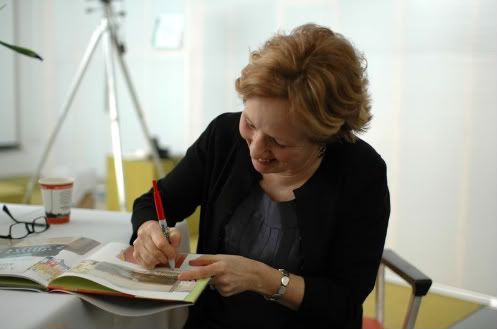
Melissa signing books at her Caldecott party in Portland, Maine, March 2009.
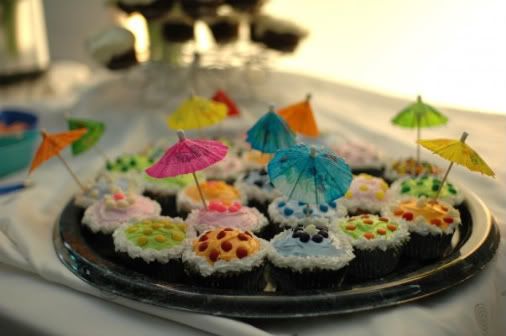
Of course there were cupcakes.
How did this project come to you, and what made you say yes to it? Did you know right away that you wanted to illustrate Jen Bryant’s text?
Gayle Brown, the art director at Eerdmans Books for Young Readers, had seen another nonfiction book I did, The Boy Who Drew Birds by Jacqueline Davies. I said “yes" pretty much right away. Though I didn’t know a lot about WCW, I wanted to do this book -- it was a big challenge. I really had no idea how I would render it at that time.
In your Illustrator’s Note, you talk about going to Rutherford and Paterson, New Jersey, to research, take pictures, and sketch. What details about Williams’ life intrigued, excited and/or surprised you most during this discovery phase?
The few poems of his I had heard were the ones many people know: "The Red Wheelbarrow," "This is Just to Say," "The Great Figure." When I went to Paterson, I thought about him making house calls there as a doctor, and saw the house where he lived and practiced in Rutherford. Somehow, going there, (going anywhere to do research), makes it more real. These were the streets he drove down, here’s the Passaic River, the library, etc. The research for a non-fiction book can be done from home, but I find I get more in touch with the person just by being where they were. Pictures can’t do that.
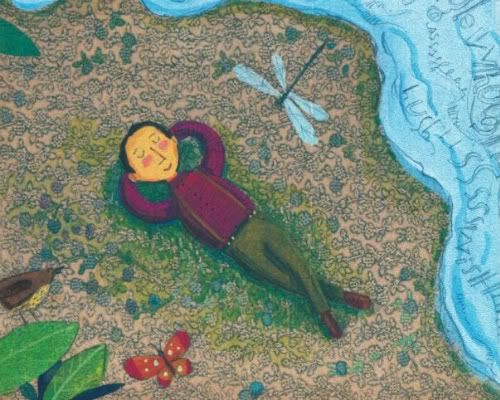
"The river's music both excited and soothed Willie. Sometimes, as he listened to its perfect tune, he fell asleep." (A River of Words, 2008).
When I was working on The Boy Who Drew Birds, I went to Mill Grove, Pennsylvania, where the book takes place, and visited the house where Audubon lived. When I saw the attic room that was his bedroom and studio, I felt like I had the whole book. It gives me a sort of impression even if I don't actually use the material I've gathered.
You also said that this book was a “true gift.” How did working on it stretch you as an artist? Was it the most challenging project you’ve ever done? How long did it take you to complete it?
It took one month to do the final art. When I finally decided how to do it, I just went for it. I didn’t know if I could pull it off. Gayle Brown loved a sample piece and was so encouraging. It was a wonderful project where the stars aligned. I don’t know if I’ve ever felt the kind of freedom I had from start to finish. It was one of the easiest projects on one hand, and the magnitude of his poems was a privilege to work with.
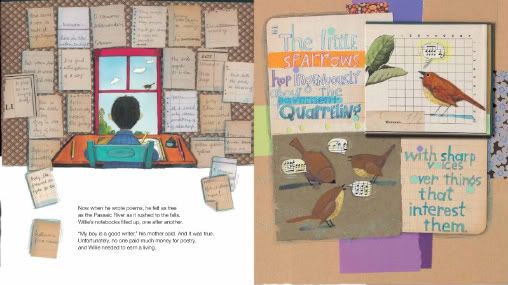
Spread featuring "Pastoral," by William Carlos Williams.
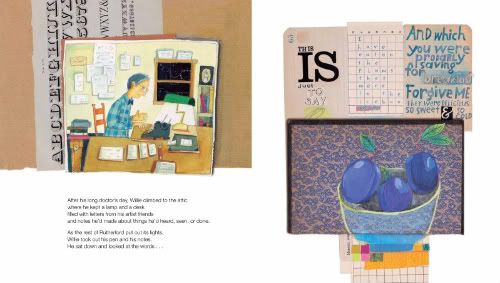
Spread featuring "This is Just to Say."
Do you have a favorite illustration from the book, a favorite poem?
The last image from the book, of WCW writing in his attic room. The poem is "11/1" (excerpt from The Descent of Winter), and he mentions the Pleiades. I spelled Pleiades wrong in the art a couple of times, and kept going over it to get it right. I could practically smell the night after reading that poem.
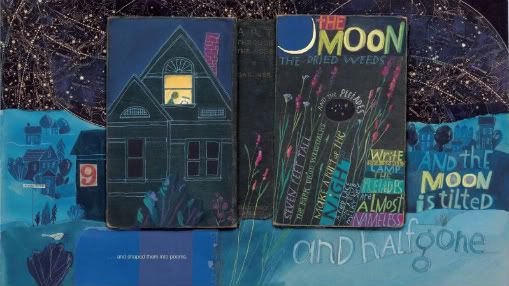
Melissa's favorite illo from the book.
Using any one of the illustrations from the book as an example, briefly explain how you created it. What was your favorite part of the process?
I started by gathering images, typography, book covers, getting a pile of stuff nearby to work with. We can talk about "The Great Figure," (the one in reds with the big FIVE).
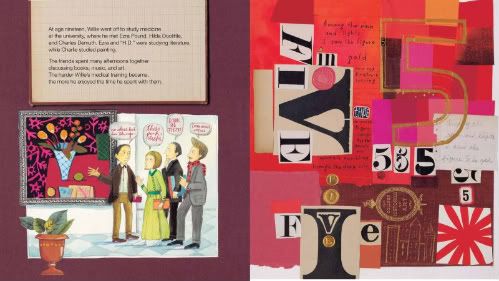
Spread featuring "The Great Figure."
I start with the background, add some paint, then begin to place the type and maybe do an overlay of the poem to get a sense of how much room it will take. I push the pieces around; at a certain point it becomes a design problem. How is this working as a piece of art? Is the emphasis where I want it? Then, if anything I’ve added feels wrong, out it goes. It’s intuitive. You know when it’s finished because nothing else needs to be done to it.
What do you think your love for collage says about you as an artist and person? What is the most unusual found object you’ve used in your work?
I’m not certain what it means about me, but collage has always made me weak in the knees. There’s a lot of chance and trust involved -- trust that it will work out!
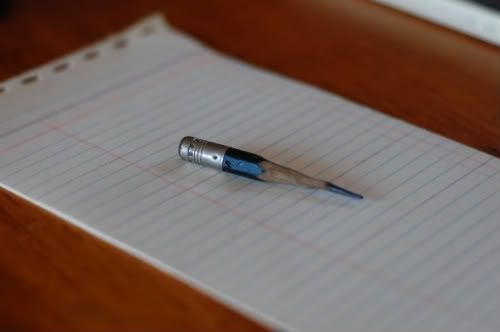
The famous pencil.
As far as the most unusual object, I have some pretty crazy stuff out here. This is it: a pencil about 2 inches long that I found in a button box. Someone had sharpened it to within an inch of its life, and the point is really long. That pencil was really used. I keep thinking I should frame it. My stepdaughter picked it up one day and I went into orbit: don’t touch that pencil! like it was the most valuable thing on the planet. The poor kid, but she’s used to me. I’m worried the point will break.
Overall, how would you describe your style for illustrating children’s books? How long did it take you to fully realize it, and what’s your preferred medium?
It took years, and each book is so different, my style really tries to reflect what the book is about. I feel like after 20+ years I’m just getting going. If I could only have one medium, it would be watercolors.
Who or what inspires you?
That’s a long list. People’s sketchbooks and studios for starters.
I absolutely love Carmine: A Little More Red, the first book you both wrote and illustrated, for its alphabetical twist and hand-drawn letters. How did you get the idea to use granny’s alphabet soup in your story? Do you often play with alphabet pasta?
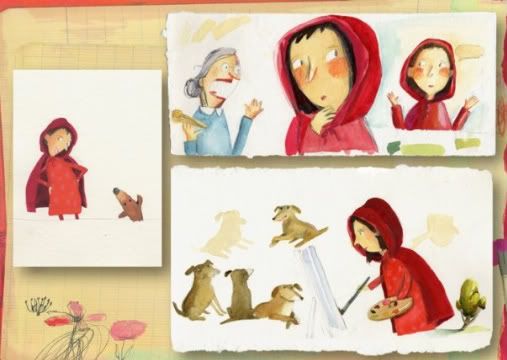
Carmine character studies.
That came out of the idea of making the book an abecedarian. When I thought about the granny’s character, I knew I didn’t want the wolf to eat her and that Carmine would go to her house for some great meal. I still associate my grandmother’s home with food. The alphabet soup came out of that -- the perfect food for an alphabet book. Then the pasta letters help hammer it home.
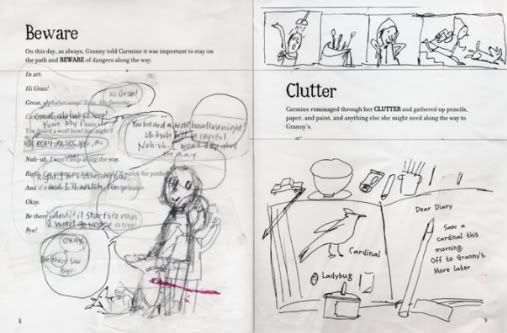
Carmine sketches.

Carmine finished art.
What can you tell us about your new book, The Sleepy Little Alphabet (written by Judy Sierra), which will be out in June?
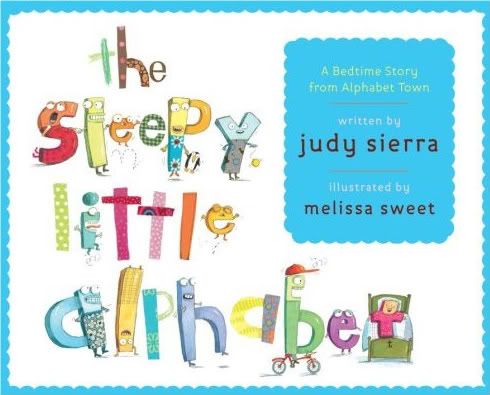
I LOVE this book. Judy wrote a wonderful, funny story about the alphabet letters (lower case) and their parents (upper case), who live in Alphabet Town. They won’t go to bed, and N is naughty, M is mopey, O and P upset the potty . . . it was a lot of fun to illustrate and make the letters into these little rascal characters.
What are you working on now?
I’m writing a biography and have a couple of other picture books for this year.
QUICK BITES
Favorite letter of the alphabet.
"N." To be honest, I love all the letters for different reasons, but N can be upside down and still look good. It's architecturally strong and makes for superb swirls. Plus, in The Sleepy Alphabet, N was "naughty" and gave me room for a bit of a sub-story. It's always helpful to have a naughty character to play off of. N endeared itself to me.
Favorite childhood food-related memory.
The first time I ever had S'mores.
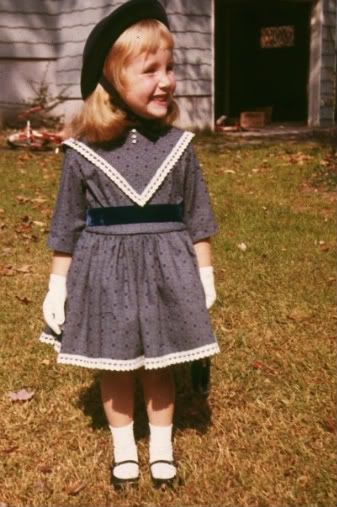
Melissa at about age 4 (awesome gloves)!
Food that inspires your best work.
Tea, black or green.
Authors and/or artists who've had the most influence on your work.
David Hockney.
Something surprising about yourself.
I cannot sing, not one wit, not one note, it's unbearable to hear me try.
You've illustrated several cookbooks, as well as the wonderful, My A-Z Recipe Box. Please share a favorite recipe with us.

This is adapted from the book, Cheese: Quick and Easy Recipes for Elegant Entertaining by Lou Seibert Pappas:
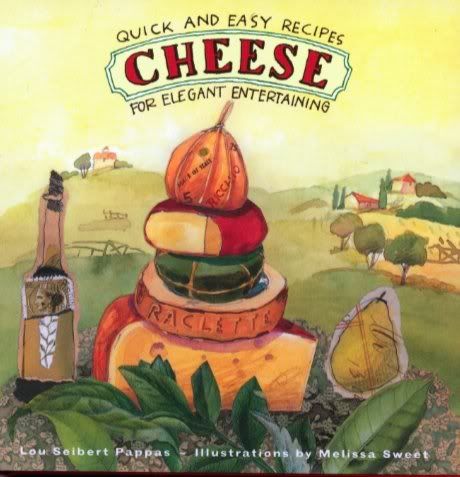
QUICK QUESADILLAS
(6) 8" flour tortillas
2 cups monterey jack cheese, shredded
1 mango or papaya, peeled and cut into small pieces
Heat a large skillet and lay down a tortilla, lightly browning one side. Flip it, then sprinkle some of the cheese and some sliced mango. Top with another tortilla and cook until cheese is melting, then flip to brown the other side. Transfer to a cutting board and cut into wedges. Serve while hot.
Make a salad, and as Carmine would say: "Voila!"
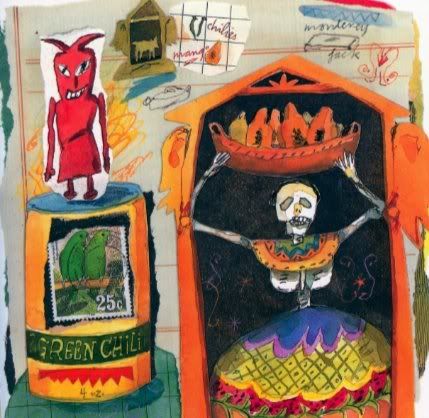
Spread from the cheese cookbook.
MORE MORE MORE:
Visit Melissa's official website and new blog!
Read more about the book at Jen Bryant's website, including a full list of all the awards AROW has received thus far.
Last September, Mary Lee at A Year of Reading interviewed Melissa, and they discussed both A River of Words and Tupelo Rides the Rails. At that time, Mary Lee voiced her strong support for A River of Words, saying she wanted to nominate it for the Caldecott!
For a look at Melissa's home and studio in Rockport, Maine, check out this awesome blog post by Alison at Shelf Talker. At the time of Alison's visit, Melissa was working on A River of Words, so there are some cool photos of the work in progress.
Tracie Vaughn Zimmer has created some great teacher guides for Tupelo Rides the Rails, A River of Words, and Carmine: A Little More Red.
Have you been to My Dog is a Bonehead yet? This website is devoted to Tupelo Rides the Rails, and will have you yipping with joy. Did you know that a portion of the proceeds from the sale of Tupelo will go to support shelter dogs and rescue causes nationwide? And, for every dog who becomes a member of the pack (i.e., official Bonehead), Melissa will make a shelter donation! Go over right now and sniff out the site!
SWEETER THAN SWEET BOOK GIVEAWAY:
Just leave a comment at this post by midnight (EST), Friday,
May 8, 2009, for a chance to win a signed copy of either A River of Words, or Cheese: Quick and Easy Recipes for Elegant Entertaining. First name drawn will win Cheese, second name drawn will win River. Mention this giveaway on your blog (let me know here), and you'll be entered twice.
If you prefer, you may enter the giveaway by emailing me: readermail (at) jamakimrattigan (dot com). Just put "Sweet Contest" in the subject line!
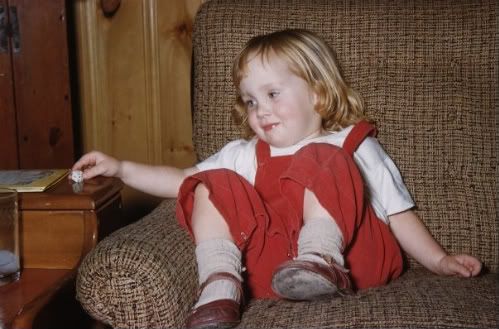
Melissa, a little more red, considers an object for a future collage.
*Spreads from A River of Words posted by permission, text copyright © 2008 Jen Bryant, illustrations © 2008 Melissa Sweet, published by Eerdmans Books for Young Readers. Spreads from Carmine: A Little More Red (Houghton Mifflin, 2005) and Cheese (Chronicle, 1996), and all personal photos posted by permission of illustrator, copyright © 2009 Melissa Sweet. All rights reserved.

Actually, you probably already know her! She has written and/or illustrated more than 70 books. Here are a few you might have seen:
Carmine: A Little More Red
The Boy Who Drew Birds: A Story of John James Audubon (by Jacqueline Davies)
The Pinky and Rex series (by James Howe)
Check out Melissa Sweet's website for a more complete list of her works.
The two books I want to focus on here are her newest, Tupelo Rides the Rails and A River of Words: The Story of William Carlos Williams (by Jen Bryant). These are the two books that grabbed me by the shoulders and shook me and made me write to Melissa Sweet out of the blue and ask her for a blog interview, to which she graciously agreed!
 Tupelo Rides the Rails
Tupelo Rides the Rails
by Melissa Sweet
Houghton Mifflin, April 2008
review copy provided by the publisher
Tupelo is a dog who, despite being dumped off by the side of a road with her sock toy, Mr. Bones, believes "Everyone belongs somewhere." She looks and looks for a place to belong, eventually hooking up with a pack of dogs who call themselves "the BONEHEADS, the Benevolent Order of Nature's Exalted Hounds Earnest And Doggedly Sublime" and a hobo named Garbage Pail Tex. The BONEHEADS and Tupelo ride the rails with Garbage Pail Tex until they get to a town where Garbage Pail Tex's hobo friends find homes for all the BONEHEADS but one. Tupelo. She makes the ultimate sacrifice in order to wish upon the dog star, Sirius, and it turns out to be worth it.


Stars are important in this book. You know that from the minute you see the star chart endpapers, and then again when Tupelo hears the dog myth of how the constellation Orion came to be leading Sirius the dog star through the sky in the constellation Canis Major surrounded by other constellations such as Canis Casa, Rubbish Canis, Great Fetching Ball, and the Seven Bones. And again, of course, when she makes her wish.
Dog heroes are important in this book. You know that from the minute you open the first of several fold-out pages and find a continuation of the star chart on the inside cover and front end paper on one side, and a time line of dog heroes throughout history on the other side.
The illustrations are sometimes in panels, giving the book an almost graphic novel feel, and sometimes in gorgeous single-page paintings like the two above. There is a hint of multi-media, when Timmy and Lassie make a photographic appearance during Garbage Pail Tex's story time on the train.
Tupelo Rides the Rails is a sweet and powerful story that makes tears come to my eyes every time I read it. I see something new in the illustrations every time I read it, too.
 A River of Words: The Story of William Carlos Williams
A River of Words: The Story of William Carlos Williams
by Jen Bryant
illustrated by Melissa Sweet
Eerdmans Books For Young Readers, August 2008
review copy provided by the publisher
"Picture book biography" just doesn't do this book justice. Jen Bryant's poetic telling of the story of Willie Williams' life and her use of the literal Passaic River of his childhood and the metaphoric flow of his words and poems, and Melissa Sweet's multimedia illustrative interpretations of Williams' poems mesh PERFECTLY. I'd like to take this opportunity to nominate this book for the Caldecott Medal!

 This book also has important endpapers -- all of the poems that are mentioned or excerpted in the text or the illustrations are found there.
This book also has important endpapers -- all of the poems that are mentioned or excerpted in the text or the illustrations are found there.
In the Illustrator's Note in the back of the book Sweet writes about her "inadvertent" connection to William Carlos Williams, and about her research. She writes this about the media she used for the illustrations:
"These pictures needed to convey his era and the modern art of his time that was so influential to Williams. There were a lot of false starts -- nothing I did seemed powerful enough to match his poems. Then I looked to a big box of discarded books I had from a library sale. One of the books had beautiful endpapers and I did a small painting on it. Then I took a book cover, ripped it off, and painted more. The book covers became my canvas, and any ephemera I had been saving for one day became fodder for the collages."
This book could have so many uses in the classroom -- as a mentor text for students writing biographies, in an art class to explore the visual interpretation of poetry, in writing workshop to reinforce the ways writers use their notebooks to capture small moments they can go back to and write about later.
Besides being
used, it needs to be
pored over. The details and layers of meaning in the illustrations are simply astounding. You just can't get tired of looking at this book!
Enough of my babbling. On to the interview.
Me: First, some questions about
Tupelo Rides the Rails. You explain on the back flap how you came to combine stars, dogs, and trains in
Tupelo. Could you tell a little about how the hobos fit in?
MS: The idea to include a hobo came when I realized the dogs needed someone to help them get to their homes. I made a list of everyone who might ride a train and that’s when the hobos came into play. An added benefit was the thought that, without regular baths, a hobo might smell mighty good to a dog. I could imagine hobo who appreciated dogs and stars as well.Me:
Tupelo seems almost multi-media, with the fold-out pages, the star chart endpapers, the time line of dog history...could you talk a little about your design process for this book, and how it fits in with all the books you’ve illustrated?
MS: It’s a very different process illustrating a story I’ve also written. It took a few years to get this story right and I thought about it constantly. I don’t have that luxury when I’m under deadline for other books—my time with the manuscript is limited. The design was shaping up to be a 40 page book, but we needed just a little more space to tell the story, yet a 48 page book seemed too long. The gatefolds allowed me to extend the story in certain places. They also reminded me of a train schedule unfolding, or a map. I didn’t want this book to be read fast, I wanted it to move along, but more chug along (like the train!) and to feel like a journey, which it is.
I tell students that making a book is like making a movie and there are about 32 frames (pages) to tell the story. How we utilize that space is big part of my job. Using the comic book device of breaking up pages into panels helps give more space. Tupelo is a simple story on one hand, but multi-layered because of the addition of the celestial legends and the dog hero information.Me: Some of the pages of
Tupelo are illustrated in panels. Have you ever considered writing or illustrating a graphic novel?
MS: Yes, and all I can say is stay tuned. I grew up with comic books and love how a story is told in panels of all kinds. I need about five lifetimes to do all the books I want to do.Me: Tell a little about the dogs in your life. Did you grow up with dogs? And what makes your brother Sandy a “legend among border collies?” (from the acknowledgments in
Tupelo)
MS: We always had a dog, or three. There were all kinds of terriers that were hard to train little devils. Then when it was time to get a dog with my own family, we decided it would be a shelter dog. Maine has an incredible placement rate for rescue dogs. It’s safe to say my family is completely embarrassed by all the gushing I do over our two dogs. But I find I never get bored of watching them. My brother has adopted border collie rescue dogs. They are notoriously smart and watch my brother as if waiting for his every move and command. He is their leader and hero, to be sure.Me: Please share with our blog readers a little about your
MY DOG IS A BONEHEAD website and your work with shelters and rescue dogs.
MS: After the book was done it felt like a natural segue to have some sort of shelter support come out of the book. The website was designed so kids, and adults, could join the BONEHEADS Pack online by filling out a form about their dog and downloading a picture of them. It doesn’t cost anything to join. I put the dogs up on the site and for every dog that joins I give a shelter donation. A portion of the sales from the store on the site will go to rescue causes, and a portion of my royalties as well. In addition I offer a signed print from the book for shelters to use in their auctions. We’ve got a pretty good-sized pack now on the site now and I’ve found people write hilarious things about their dogs. The very best thing that’s happened regarding the shelters was at the launch party I had here in my town. The local shelter was there with information and they brought a beautiful rescue dog who was adopted that day. It doesn’t get much better than that.Me: Now let’s hear about
A River of Words: The Story of William Carlos Williams, by Jan Bryant.
First of all, thanks for the artist’s note in the back of the book. It’s always nice to learn about the materials/media that were used by the artist. Would you tell a little about the “ephemera” you’d “been saving for one day” and how you created the collages?
MS: This book had a woefully skimpy dummy and not many sketches. Although I had done extensive reading about WCW and visited his town, I was beginning to panic. I didn’t have a handle on how to render this book. The deadline was on the heels of Tupelo and I was feeling almost out of gas. I had saved some beautiful end boards from an old book with a subtle print and a good quality paper. I tried painting on it and it worked great. Then I tried using book boards as my canvases instead of starting on paper. It was just the thing I needed to propel me. It was new and fresh and I had such momentum from it. I’ve been buying old books, notebooks, atlases for years and for this project I used whatever I wanted—nothing was saved for another project. The collages are done like a painting. I start with a background, then add more objects and push things around until I feel it’s done. I approach it as a design problem so I’m considering the colors, composition etc. When I collect or buy collage materials I don’t necessarily know how I’ll utilize them. I just know I have to have them.Me: Again from the artist’s note, it seems that you had an unusually strong connection to this book. Can you tell us about that?
When I was seven I went with my brownie troop to the Metropolitan Museum of Art in NY City. I came home with a souvenir postcard of a painting by Charles Demuth, The Great Figure. It is an abstract painting of a fire engine racing the city on a rainy night. I loved that painting and was pretty pleased I understood the imagery and could feel the urgency of the fire truck. Fast forward 40+ years and Eerdmans calls me about this biography of William Carlos Williams. The working title was The Great Figure, from his poem that begins: "I saw the figure five in gold." I had seen this poem and I wanted to know if WCW had written the poem after seeing the painting. It turned out the poem had been penned by WCW one night on his way to Marsden Hartley studio, where he then he gave it to Demuth. It was serendipity, and I thought, I’ve come back to this painting! I think this goes under the category of: You never know what will influence your child along the road of life.Me: How did you come to be the illustrator for this book? Had you worked with Jen Bryant or Eerdmans Books before?
MS: No, this was my first time with both. I believe they chose me because Gayle Brown, the art director, had seen the book I illustrated, The Boy Who Drew Birds about John James Audubon. Gayle was wonderful to work with and really trusted my process, for which I am extremely grateful.Me: Some general questions next. What was your formal art training?
MS: I have an Associates Degree in Art from Endicott College and attended the Kansas City Art Institute as well as the Museum School in Boston. After that, I went anywhere there was a course I wanted to take, or I took classes wherever I was living. I still love to take classes in anything. Blacksmithing, papermaking, tin toys, you name it, I’m there.Me: Can you describe your typical workday? (If such a thing exists!)
MS: My work day is from about 8am to 2pm or 3pm , five days a week. I’ve stuck to this for the last 20 years and it’s been a good discipline. I never make appointments during that time. It’s all mine. It allows a lot of work to get done and even if I’m just drinking tea and reading in the studio, I consider myself working.Me:
A River of Words and
Tupelo Rides the Rails are both 2008 books. Were you working on them at the same time? How did they influence each other? (I see they both have star charts, for instance.)
MS: Thank goodness for color Xeroxes…Those star charts have served me well. Tupelo took a good deal of time and consideration to make all the elements work together. It really absorbed me. As soon as it was done, I had to jump in and begin the art for this book. I went wild with the collages for A River of Words. I don’t think I would’ve had the same freedom had I not poured my soul into Tupelo. I needed a sense of abandon, and thought of all the soirees Williams attended in New York, all the modern art he loved. I tried not to censor and trust my hunches. One thing I’ve learned after many projects is that the process is not a function of time. I’ve found I work best with a deadline and the proverbial gun to my head. It forces me to make decisions and everything we do in a book is a decision. Artists have to make marks to have something to respond to, and it’s the same with writing. The early writing I do for a book looks pretty sorry, but it gives me a starting point. I have William Stafford’s quote that talks about “ lowering one’s standards in order to write” and I find that’s very helpful with art or writing. Not every day is going to be extraordinary.Me: What are you working on now (if you can say)?
MS: I can’t say. I heard Richard Russo once say his next book is about 350 pages, so mine is about 48 pages.Me: What is your all-time (or current, you pick) favorite medium for your art?
MS: I love using gouache. I’m not sure life would be worth living without it.Me: What is your favorite book out of the 70+ you’ve written and/or illustrated? (Again, if such a thing exists!)
MS: In the spirit of diplomacy, I love them all for different reasons. But Carmine was so much fun, and I never dreamed I’d get to use the word “nincompoop” in a book.Me: And now, some questions just for fun:
Coffee or tea?
Tea, PG tips to be specific.Vanilla or chocolate?
Vanilla.
TV, DVD, or movie theater?
The movies, so long as it’s not a megaplex. We don’t have TV but I download Project Runway on YouYube religiously.Classical or jazz?
Jazz or Leonard Cohen.
Beach, mountain, or forest?
All the above and maybe back-road bicycle ride too.Early bird, or night owl?
Early bird.Hardback, paperback, or magazine?
The New Yorker, or whatever I’m researching next.Thank you, Melissa, for agreeing to this public sort of chat! I've...or shall I say,
we've enjoyed getting to know you and we look forward to your next books!
For a tad bit more information, see
Kids Q & A at Powell's.
All illustrations courtesy of Melissa Sweet. Posted with permission. All rights reserved.
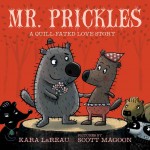 Mr. Prickles
Mr. Prickles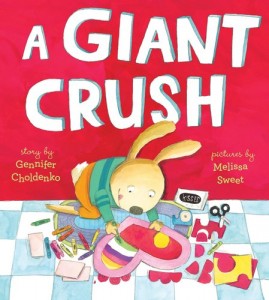 A Giant Crush
A Giant Crush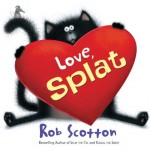 Love, Splat
Love, Splat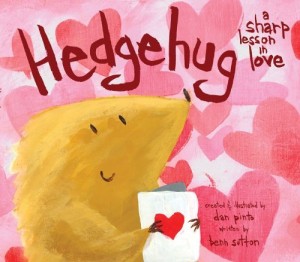 Hedgehug
Hedgehug 





































































Thanks for an informative review, the links, and for sharing your memories!